МІСЦЕ SMART WATCH У РЕАЛОГІЇ: КІБЕРКУЛЬТУРНИЙ АНАЛІЗ
DOI:
https://doi.org/10.31392/cult.alm.2022.3.31Ключові слова:
Smart watch, реалогія, річ, функціональність речі, річ як символ, кіберкультурний аналізАнотація
У роботі проведений кіберкультурний аналіз Smart watch як одиничної речі, що впливає на життєвий світ людини, формування її світогляду. Презентована реалогія як нова галузь гуманітаристики, що нестандартно вивчає в речах їх нефункціональний символічний сенс. Виявлений методологічний поворот у сучасному гуманітарному знанні до реалогії як аналізу світу речей у повсякденних практиках культури, що дозволяє трактувати символізм речі (наприклад, Smart watch) як форми особистісної вкоріненості у бутті культури.
Посилання
Apple watch human interface guidelines. URL: https://developer.apple.com/watchos/humaninterface-guidelines/
overview/.
Barthes, Roland (1983). Système de la mode. Editions du Seuil, 330 p.
Barthes, Roland. (1977). Elements of Semiology. Farrar, Straus and Giroux, 111 p.
Barthes, Roland (1972). Mythologies. Farrar, Straus and Giroux (edition).
Epstein, Mikhail (2019). A Philosophy of the Possible: Modalities in Thought and Culture. Transl. by Vern W. McGee and Marina Eskina. Boston, Leiden et al: Brill Academic Publishers / Rodopi (Value Inquiry Book Series), 365 p.
Huang, J., Badam, A., Chandra, R., and Nightingale, E. B. (2015). Weardrive: Fast and energy-efficient storage for wearables. In USENIX ATC.
Kate Crawford, Jessa Lingel and Tero Karppi. (2015). Our metrics, ourselves: A hundred years of self-tracking from the weight scale to the wrist wearable device. European Journal of Cultural Studies, 18(4-5), P. 479–496.
Liu, R., and Lin, F. X. (2016). Understanding the Characteristics of Android Wear OS. In MobiSys, 2016.
Mark T Smith. (2007). Reconciling ICT and Wearable Design: Ten Lessons from Working with Swatch. The Role of Design in Wearable Computing, P. 16.
Melanie Swan (2012). Sensor Mania! The Internet of Things, Wearable Computing, Objective Metrics, and the Quantified Self 2.0. Journal of Sensor and Actuator Networks, 1(3), P. 217.
Miao, H., and Lin, F. X. (2016). Tell your graphics stack that the display is circular. In HotMobile.
Optimizing for Doze and App Standby. URL: https://developer.android.com/training/monitoring-device-state/doze-standby.html.
Reza Rawassizadeh, Blaine A Price and Marian Petre (2014). Wearables: has the age of smartwatches finally arrived? Communications of the ACM, 58(1), P. 45–47.
Rightspot: A novel sense of location for a smart personal object. in (Dey, A., Schmidt, A. and McCarthy, J. eds). UbiComp: Ubiquitous Computing, Springer Berlin Heidelberg, 2003. P. 36–43.
Santagati, G. E., and Melodia, T. (2015). U-Wear: Software-Defined Ultrasonic Networking for Wearable Devices. In MobiSys.
Sending and Syncing Data with Watch. URL: https://developer.android.com/training/wearables/data-layer/index.html.
Shen, S., Wang, H., and Choudhury, R. R. (2016). I am a smartwatch and i can track my user’s arm. In MobiSys.
Smartwatches now more popular than Swiss watches. URL: https://www.cnet.com/news/smartwatches-nowmorepopular-than-swiss-watches-thankslargely-to-apple/.
Specification of the Bluetooth System (Core Specification). URL: https://www.bluetooth.com/specifications/adopted-specifications, 2014.
Zhang, L., Tiwana, B., Qian, Z., Wang, Z., Dick, R., Mao, Z. M., and Yang, L. Accurate Online Power Estimation and Automatic Battery Behavior Based Power Model Generation for Smartphones. In CODES+ISSS, 2010.
Єрмоленко В. (2017). Барт, або Втрата. Володимир Єрмоленко. Далекі близькі. Есеї з філософії та літератури. Львів : Видавництво Старого Лева. С. 205–226.
Барт Ролан. (2022). Філософський енциклопедичний словник / В.І. Шинкарук (гол. редкол.) та ін. Київ : Інститут філософії імені Григорія Сковороди НАН України : Абрис. 742 с. С. 47.
Розова Т.В., Чорна Л.В. (2015). Людина. Культура. Філософія. (Проблема людини в європейській філософії) Книга 1. Київ-Одеса : Освіта України. 328 с.
Русаков С.С. (2020). Теоретична модель колообігу культури як культурологічний підхід у вивченні феноменів сучасної культури. Питання культурології. № 36. С. 24–37. URL: https://doi.org/10.31866/2410-1311.36.2020.221040.








